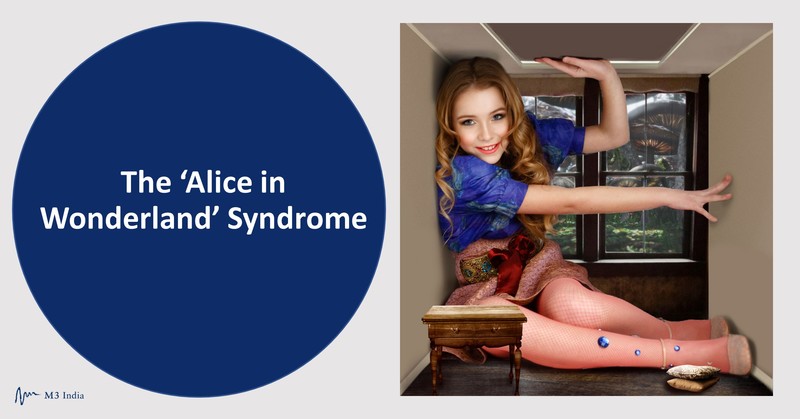The ‘Alice in Wonderland’ syndrome: A primer
M3 India Newsdesk Jan 02, 2020
The Alice in Wonderland (AIWS) syndrome was first identified by Dr. Caro Lippman in 1952. However, in 1955, English psychiatrist John Todd presented a remarkable report on the syndrome and gave it the name. Here we give you a clinical overview of the disorder named after the popular fantasy tale.

The Alice in Wonderland Syndrome (AIWS)
AIWS, a neurological disorder, as identified by Dr. Todd, is marked by an experience one has about their own body image being distorted in size, volume, shape or position and the perceived paroxysmal illusion is often combined with a sense of unreality. The specific symptoms that Dr. Todd described were based on 6 cases that he had discovered, most of which resembled the experiences that ‘Alice’ from the book ‘Alice’s Adventures in Wonderland’ had and hence, the name.
Recognising AIWS- These are not hallucinations or schizophrenic disorders
More than 40 types of perceived distortions have been noted for AIWS so far. Some of the most commonly reported symptoms are as under:
- Micropsia- Perceiving one’s own body as being smaller in size/mass/shape
- Macropsia- Here the perception is of one’s own body being larger in size/mass/shape
- Teleopsia- Where things seem relatively further away than their actual position
- Dysmorphopsia- Where straight lines appear wavy
- Plagiopsia- Some patients perceive objects in a slanted position, all in the same direction, at the same angle
- Prosopometamorphopsia- Perceiving a single type of distortion in all the faces around. The type of distortion may change but applies consistently to every face.
These perceptions are consistent, and the distortion is relative and applicable to any object in the patient's visual range. The distortions are related to sensory perception and are different from hallucinations. Also, given the significantly different diagnostic and therapeutic consequences, it is safe to say that the symptoms are different from those of schizophrenic disorders, as well.
A remarkable detail about these symptoms is that once the patient has visually fixated on an object, the metamorphopsia can start after a few seconds or minutes. Through that interval of the temporal delay, the perceptual process is continuous. Clinically, the phenomenon is a sign of cerebral asthenopia. The symptoms can last from anything between minutes to days to years or even a lifetime.
As per the reported cases, encephalitis, which is caused due to the Epstein-Barr virus infection, is the most common reason of AIWS in children. As for adults, migraine is said to be the root cause of AIWS.
AIWS needs attention
Clinical studies indicate that symptoms of AIWS are not as rare anymore and its prevalence among patients of migraine can be as high as 15%.
The number of cases that have been clinically acknowledged as AIWS is only 180 and an apparent quick rise in the number has now called for medical attention.
Three cross-sectional studies were conducted in different age groups and published in the article ‘Alice in Wonderland syndrome: A systematic review’ by Blom JD. [2016]. These reflect the increasing rate of occurrence of AIWS symptomatology:
- Results of 1st cross-sectional study with 1,480 adolescents: Lifetime micropsia and/or macropsia in 5.6% males and 6.2% females.
- Results of 2nd cross-sectional study with 3,224 high school students:
- 3.8% micropsia,
- 3.9% macropsia,
- 2.5% for protracted duration, and
- 1.3% for quick- motion phenomenon, all with a prevalence rate of 6 months
- Results of 3rd cross-sectional study in 297 individuals, with a median age of 25.7 years:
- Lifetime prevalence of teleopsia in 30.3%, dysmorphopsia in 18.5%, macropsia in 15.1%, and micropsia in 14.1%
- 38.9% (affected) individuals experienced a single symptom
- 33.6% of them experienced 2 symptoms
- 10.6% of them experienced 3 symptoms
- 16.8% of them experienced 4 symptoms
Conclusion of the studies
- The evident increase may point toward a common aetiologic process as a cause for the mediation of all 4 symptoms.
- It could also be a stochastic process, wherein one symptom lowers the threshold for another one to get added.
This also gives rise to a possibility of finding anything within the brain’s networks that may be responsible for the mediation of symptoms – another reason for the renewed interest in AIWS.
Remarkably, researchers Naarden T, et al., in their paper titled ‘Alice in Wonderland Syndrome as a Presenting Manifestation of Creutzfeldt-Jakob Disease’, presented their clinical case of Creutzfeldt-Jakob Disease (CJD, Heidenhain variant), wherein the patient demonstrated symptoms of AIWS. However, an MRI of the head and examination of the cerebrospinal fluid (14-3-3 protein) confirmed sporadic CJD. They concluded that if symptoms of AIWS are combined with a rapid cognitive decline, an extensive differential diagnosis for CJD must be included.
Since these studies, there has been a marginal increase in the number of complainants of the symptoms of AIWS, and adult patients with migraine form about 15% of these complainants.
The derived pathophysiology of the disorder seems to give medical experts hope for making new discoveries by studying the brain’s networks. However, the term – Alice in Wonderland syndrome should not be used loosely for patients suffering from somaesthetic perceptual disorders, hallucination or isolated visual illusions, and/or spectrum disorders linked to schizophrenia.
It is possible to obtain a full remission of the symptoms for cases of AIWS. If the underlying chronic condition is known, the specialist should assess the treatment thoroughly before prescribing and share the possible consequences of each medication with the patient, helping him or her in faster recovery.
-
Exclusive Write-ups & Webinars by KOLs
-
Daily Quiz by specialty
-
Paid Market Research Surveys
-
Case discussions, News & Journals' summaries